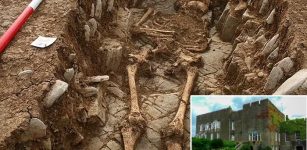Ancient Codex Cospi: Intriguing Pre-Columbian Ritual Manuscript From Central Mexico
A. Sutherland - AncientPages.com - On December 26, 1665, the Codex Cospi (or Codex Bologna) was given as a Christmas gift to the Italian nobleman Ferdinando Cospi (1606 - 1686).
Left: Unknown author /source (originally uploaded to the Polish-language Wikipedia by Adamt - Public Domain; Right: Picture of Tlāhuizcalpantecuhtli (Codex Cospi) Image credit: pixelsniper - CC BY 2.0 DEED
The gift is a pre-Columbian well-preserved, ritual screenfold manuscript, decorated with many illustrations and with the front cover, marked with four golden fan designs, specially created for that gift in Rome or Bologna, around 1665.
This codex was first recognized as a Mexican 'hieroglyphics' book in 1677; however, its precise date remains unknown. The intriguing document was also partially interpreted, but the study's results were unfortunately postponed forever.
Two different masters worked on the front and back sides of the codex.
Its front side contains three sections of pictures linked with dates, used for divination. The back side depicts eleven rituals.
Codex Cospi is a beautiful illuminated manuscript, protected by two covers made in the 17th century, probably to replace former older, wood covers. Image credit: Biblioteca Universitaria di Bologna
In its original screen-fold presentation, the Codex Cospi is 3.64 m long and contains twenty square leaves. Each of the 20 cards has the form of a square with a side length of about 18 cm.
It is made of five hard, polished deer skins, formed into rectangular strips joined together and forming one long, screenfolded strip, similar to an accordion. When closed, it looks like a square book about 178 mm high and its each page is 178,5 mm wide. Average thickness of the folded book is 20 mm.
The manuscript's content is divided into 4 parts. Three located on the front (obverse) side were written and illustrated by one scribe, and the fourth part on the back (reverse) side, has not the same high quality and was most probably prepared by a different and less skilled scribes.
External cards were added in the seventeenth century with the protective functions of additional parchment cards.
Part one, including pages from the first to the eighth contains a calendar of predictions, called ‘tonalpohualli’.
Offerings are made by the sun god, top, and the god of darkness, below. Sun god stands before a temple in which an eagle is enthroned, while the god of darkness stands before a temple inhabited by the rational owl, a symbol of utter destruction. Mexico. Mixtec, 1350-1500 Image credit: Santa Rosa Junior College
From the pages nine to eleven, there are depictions of Tlahuizcalpantecuhtli (Lord of the Dawn), the god of the planet Venus (the Morning Star) throwing spears at symbols of power, badly affecting the layout of the planets on each day of ritual calendar.
According to Aztec mythology, these negative symbols are Centeotl, the God of Maize widely associated with the Pleiades, the water goddess Chalchiuhtlicue ("Woman of the Jade Skirt"), linked with running water and rivers, springs, and lakes, who brings fertility to crops.
Other negative symbols represent a throne, a water mountain, and a jaguar holding a human heart.
Part three is related to the directions of the world. It depicts four gods, each of whom is burning incense in front of four temples.
These gods are: to the East, the Sun God Tonatiuh, to the West, the Maize God Cinteotl, to the North, the blind Itzlacoliuhqui (“Bent Obsidian Knife”), God of Cold, and finally, to the South, there is the Death God Mictlantecuhtli.
Based on historical sources, it is believed that the Codex Cospi (similar to other codices) was read aloud, during chant-like performances.
The Codex Cospi like other prehispanic codices, represents the religious and historical legacy of the pre-Columbian people of Mesoamerica. It was produced with the help of hieroglyphs and ideographs, to record historical events, politics, and religious matters such as calendars, rituals, divination.
It is believed that it originates from the region of Tlaxcala located in central Mexico, an ancient place where human life appeared as early as 10,000 BC, according to archaeological evidence.
The codex is currently located in the library of the University of Bologna.
Written by – A. Sutherland AncientPages.com Staff Writer
Updated on March 31, 2024
Copyright © AncientPages.com All rights reserved. This material may not be published, broadcast, rewritten or redistributed in whole or part without the express written permission of AncientPages.com
Expand for referencesMore From Ancient Pages
-
 Evidence Humans Have Been Using Bear Skins For At Least 300,000 Years Discovered
Archaeology | Dec 27, 2022
Evidence Humans Have Been Using Bear Skins For At Least 300,000 Years Discovered
Archaeology | Dec 27, 2022 -
 Untouched 1,300-Year-Old Grave Of Merovingian Warrior With Complete Armor Found In Ingelheim, Germany
Archaeology | Sep 19, 2023
Untouched 1,300-Year-Old Grave Of Merovingian Warrior With Complete Armor Found In Ingelheim, Germany
Archaeology | Sep 19, 2023 -
 Bertrand du Guesclin: ‘Eagle Of Brittany’ Brave, French Commander And His Clash With Sir Thomas Of Canterbury
Featured Stories | May 1, 2023
Bertrand du Guesclin: ‘Eagle Of Brittany’ Brave, French Commander And His Clash With Sir Thomas Of Canterbury
Featured Stories | May 1, 2023 -
 Mysterious Medieval Cemetery In Wales With People Buried In Unusual Positions Puzzles Archaeologists
Archaeology | Jan 3, 2024
Mysterious Medieval Cemetery In Wales With People Buried In Unusual Positions Puzzles Archaeologists
Archaeology | Jan 3, 2024 -
 Why Did Christian Viking King Harald Bluetooth Carry A Hammer Of Thor Amulet?
Artifacts | Apr 20, 2018
Why Did Christian Viking King Harald Bluetooth Carry A Hammer Of Thor Amulet?
Artifacts | Apr 20, 2018 -
 4,000 Years Ago Women Of El Argar Used Their Teeth As Tools
Archaeology | Nov 10, 2020
4,000 Years Ago Women Of El Argar Used Their Teeth As Tools
Archaeology | Nov 10, 2020 -
 Incredible Trove Of 100,000 Ancient Coins Tied Together In Bundles Uncovered In Japan
Archaeology | Nov 13, 2023
Incredible Trove Of 100,000 Ancient Coins Tied Together In Bundles Uncovered In Japan
Archaeology | Nov 13, 2023 -
 On This Day In History: Canute – Cnut The Great – Danish King Of England Died – On Nov 12, 1035
Featured Stories | Nov 12, 2016
On This Day In History: Canute – Cnut The Great – Danish King Of England Died – On Nov 12, 1035
Featured Stories | Nov 12, 2016 -
 Mystery Of The Man Whose Supernatural Abilities Still Captivate Scientists
Featured Stories | Jan 16, 2023
Mystery Of The Man Whose Supernatural Abilities Still Captivate Scientists
Featured Stories | Jan 16, 2023 -
 230,000-Year-Old Human Remains Discovered In Eastern Africa – Rewrite Ancient History
Archaeology | Jan 14, 2022
230,000-Year-Old Human Remains Discovered In Eastern Africa – Rewrite Ancient History
Archaeology | Jan 14, 2022 -
 When Giants Ruled North America – Giant Skeletons ‘Erased’ From History – Part 2
Ancient Mysteries | Nov 22, 2018
When Giants Ruled North America – Giant Skeletons ‘Erased’ From History – Part 2
Ancient Mysteries | Nov 22, 2018 -
 3,000-Year-Old Nimrud Lens Could Re-Write The History Of Science – Was The World’s Oldest Telescope Developed By Ancient Assyrian Astronomers?
Ancient Technology | Oct 19, 2014
3,000-Year-Old Nimrud Lens Could Re-Write The History Of Science – Was The World’s Oldest Telescope Developed By Ancient Assyrian Astronomers?
Ancient Technology | Oct 19, 2014 -
 Sir Marc Aurel Stein: Famous Fascinating Expeditions To Ancient Places Of The Silk Road
Civilizations | Feb 11, 2016
Sir Marc Aurel Stein: Famous Fascinating Expeditions To Ancient Places Of The Silk Road
Civilizations | Feb 11, 2016 -
 Sir William Wallace: Brave Scottish Knight And Legendary Hero
Featured Stories | Feb 27, 2016
Sir William Wallace: Brave Scottish Knight And Legendary Hero
Featured Stories | Feb 27, 2016 -
 Ancient Secrets Of Sophisticated Jama-Coaque People
Civilizations | Sep 27, 2016
Ancient Secrets Of Sophisticated Jama-Coaque People
Civilizations | Sep 27, 2016 -
 Early Harappan Burial Site With 26 Graves Unearthed In Kutch, Western India
Archaeology | Mar 14, 2019
Early Harappan Burial Site With 26 Graves Unearthed In Kutch, Western India
Archaeology | Mar 14, 2019 -
 Unique Over 1,000-Year-Old ‘Telephone’ Invented By A Lost Forgotten Civilization With No Written Language
Civilizations | Aug 24, 2018
Unique Over 1,000-Year-Old ‘Telephone’ Invented By A Lost Forgotten Civilization With No Written Language
Civilizations | Aug 24, 2018 -
 Cooper’s Ferry Site In Western Idaho Was Inhabited 16,000 Years Ago
Archaeology | Sep 3, 2019
Cooper’s Ferry Site In Western Idaho Was Inhabited 16,000 Years Ago
Archaeology | Sep 3, 2019 -
 Cosimo di Giovanni de’ Medici – Exile Of The Generous, Intelligent Banker Caused Fury In Renaissance Florence
Featured Stories | Apr 7, 2021
Cosimo di Giovanni de’ Medici – Exile Of The Generous, Intelligent Banker Caused Fury In Renaissance Florence
Featured Stories | Apr 7, 2021 -
 Levänluhta People Could Survive Fimbulwinter Thanks To Their Diverse Livelihoods
Archaeology | Apr 24, 2020
Levänluhta People Could Survive Fimbulwinter Thanks To Their Diverse Livelihoods
Archaeology | Apr 24, 2020




